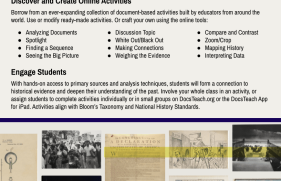Document analysis is the first step in working with primary sources. Teach your students to think through primary source documents for contextual understanding and to extract information to make informed judgments.
You can use our Analyzing Documents tool to create online activities, or these worksheets — for photos, written documents, artifacts, posters, maps, cartoons, videos, and sound recordings — to teach your students the process of document analysis.
Follow This Progression:
- The first few times you ask students to work with primary sources, and whenever you have not worked with primary sources recently, model careful document analysis using the worksheets provided below. Point out that the steps are the same each time, for every type of primary source:
- Meet the document
- Observe its parts.
- Try to make sense of it.
- Use it as historical evidence.
- Once students have become familiar with using the worksheets, direct them to analyze documents as a class or in groups without the worksheets, vocalizing the four steps as they go.
- Eventually, students will internalize the procedure and be able to go through these four steps on their own every time they encounter a primary source document. Remind students to practice this same careful analysis with every primary source they see.
Don’t stop with document analysis though. Analysis is just the foundation. Move on to activities in which students use the primary sources as historical evidence.
PDF Worksheets
For Novice or Younger Students (English/Español)
- Photograph/Fotografia
- Written Document/Documento Escrito
- Artifact/Artefacto
- Poster/Póster
- Map/Mapa
- Cartoon/Caricatura
- Video/Video
- Sound Recording/Grabación de Sonido
- Artwork/Obras de Arte
For Intermediate or Secondary Students (English/Español)
- Photograph/Fotografia
- Written Document/Documento Escrito
- Artifact/Artefacto
- Poster/Póster
- Map/Mapa
- Cartoon/Caricatura
- Video/Video
- Sound Recording/Grabación de Sonido
- Artwork/Obras de Arte
For Understanding Perspective in Primary Sources – For All Students and Document Types
This tool helps students identify perspective in primary sources and understand how backgrounds, beliefs, and experiences shape point of view.
Why teach with documents?
When we ask students to work with and learn from primary sources, we transform them into historians. Rather than passively receiving information from a teacher or textbook, students engage in the activities of historians — making sense of the stories, events and ideas of the past through document analysis.
Teaching with documents can engage students. They begin to see connections between past and present. Documents with signatures or notations personalize history. Primary sources give students opportunities to empathize with figures of the past and to understand history from varying perspectives. The varied nature of primary sources also provides students the opportunity to connect their historical understanding to other subject areas like geography or math, to a collective national heritage, and to their modern lives.
Primary sources often inspire students because they provide new avenues for learning about the past. Documents can illustrate abstract concepts or help students make connections between seemingly unrelated information. Students can begin their historical studies through graphical materials that they may be more comfortable with — photographs, maps, and posters.
Through their analysis of a variety of documents, students learn to find multiple perspectives in history. Primary sources guide students to the realization that all accounts of past events are subjective. Following practice with primary sources, students begin to recognize bias and question where historical information comes from. Students learn not only to question the reliability of sources but to reference multiple sources for information while doing historical research.
Primary sources encourage higher order thinking. As historians, students can link documents to see cause and effect relationships, fit historical pieces together to understand a whole story, understand historical events in context by relating primary sources to mathematical data or geographic locations, and assess primary sources as evidence to formulate interpretations about the past.



